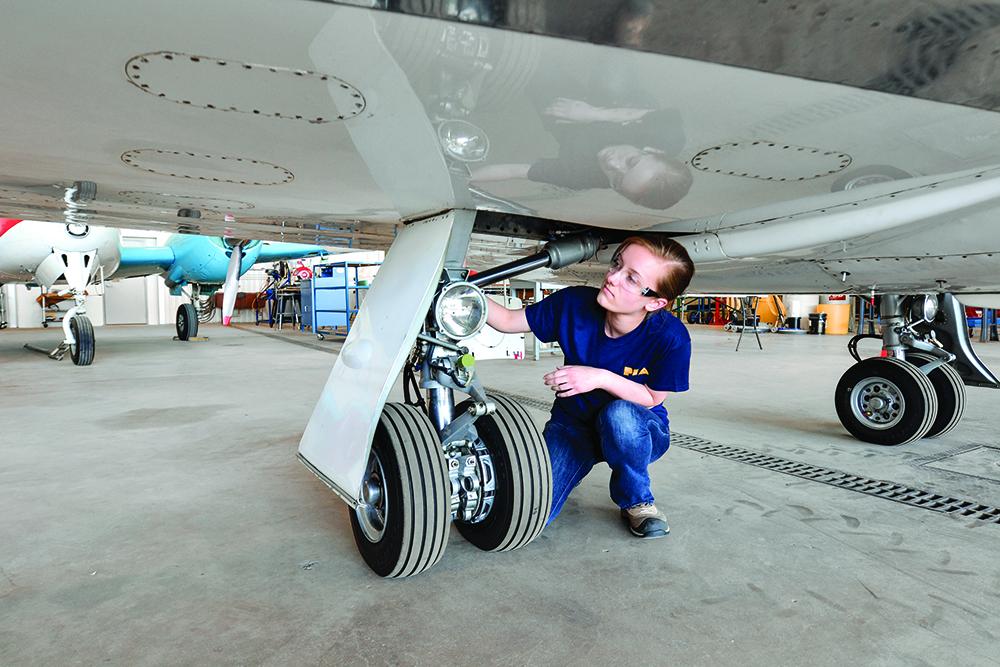
On the same day that the FAA’s new Part 147 regulations for aircraft maintenance training went into effect (Sept. 21), the Aviation Technician Education Council (ATEC) held its annual Washington Fly-In to promote a new way to develop U.S. mechanics, discuss questions about the new FAA rules and lobby Congress for support.
Crystal Maguire, ATEC’s executive director, led discussions of the new FAA rules for training mechanics. Generally, ATEC members welcome the new rules, for which they had fought for a long time, but one issue is created by transition from the old rule to the new. Although Part 147 schools were supposed to switch over to the new FAA standards on Sept. 21, 2022, the FAA’s test will not switch over to new questions until at least August 2023.
So, how should students, partially trained under one set of rules, be prepared for tests developed for other rules? FAA officials at the Fly-In said no “gap” training will be required, but schools should work with their local FAA inspectors to manage the transition. However, some attendees said their local FAA inspectors are essentially requiring gap training.
Larry Fields, acting executive director of the FAA’s Flight Standards Service, urged schools to try to resolve these inconsistencies with staff at their FAA district offices. If that does not work, he says schools should escalate the issue to FAA headquarters.
Brett Levanto, vice president of operations at the Aeronautical Repair Station Association (ARSA), argued that for both the Part 147 rule change and other areas, “Inconsistency in regulatory interpretation might be the biggest problem plaguing the FAA and the industry.”
Ryan Goertzen, vice president of workforce development at AAR, outlined ATEC’s new nonprofit organization focused on promoting aerospace technical careers, Choose Aerospace. The nonprofit was launched in 2020 with an ultra-slim budget of $20,000, working with partners such as Clemson University to develop 500 hr. of an aviation maintenance curriculum that, at a licensing cost of only $200 per student, could be taught in high schools, community-based programs, veteran programs or other platforms.
The Choose Aerospace curriculum follows the new FAA standards for training mechanics and requires limited equipment, materials and teaching qualifications, although teachers—for example, former auto mechanic teachers—must be given instruction on new subjects.
Choose Aerospace is being taught in 12 high schools with 500 students for the 2022-23 school year. Goertzen says the current crop of students is highly diverse, comprised of 25% Hispanic students, 10% Black students and 12% women students. Goertzen’s goal is to have 10,000 students in the program by 2027.
A graduate of Choose Aerospace is eligible to be hired as a non-certificated repairman by an MRO or airline, or they could move into an aircraft mechanic school, having completed about a quarter of the required courses and thus saving about a quarter of tuition.
ATEC is also seeking a change in FAA regulations that would enable Choose Aerospace graduates to take the FAA’s general knowledge written test and thus receive some sort of clear reward or certificate for successfully completing the program. FAA officials at the Fly-In seemed open to this proposal, but noted that it would require a rulemaking, which takes significant time.
Goertzen is seeking funding to promote and expand Choose Aerospace. Unsuccessful in seeking Federal grants, he is now asking for multi-year support from the aviation industry. Goertzen says he met with Southwest Airlines, which, like other operators and shops, will soon face challenges in obtaining experienced mechanics. He plans to meet with United Airlines and American Airlines as well, adding: “I am confident the industry will pony up.”
ATEC attendees generally applauded Choose Aerospace, but emphasized that getting qualified teachers and reaching out to parents and students will be crucial to its success.
“The Choose Aerospace model is fantastic,” says ARSA’s Levanto, calling it a “stackable” approach to training, in which basic knowledge can be added to in many ways, producing many opportunities for students, schools and employers.




